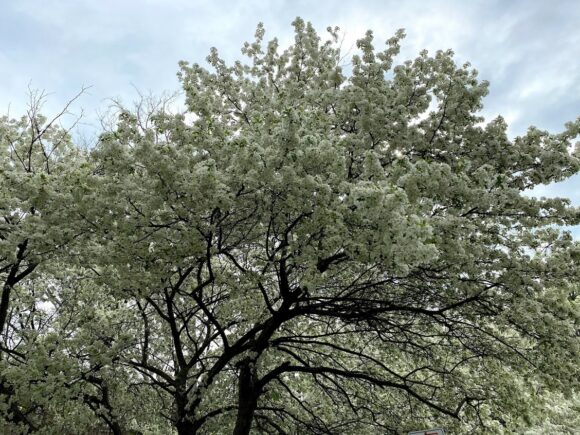
OLD LYME — The darling buds of May” is such an apt phrase for one of the most enchanting months, bloom on bulbs and trees and the fresh foliage on trees winking in the sun.
By now, you have probably removed most of the winter debris, pruned broken branches and re-edged borders. Do not however, apply that spring layer of composted manure as the soil needs to warm up to 60 degrees for the soil organisms to accept the bacteria of the manure in order to produce nutrients for the roots of the plants.
When shopping for garden supplies, pick up a soil thermometer to check soil temperature and I am sure the right temperature will be reached in about two to three weeks.
I am seeing our old nemesis, weeds springing up everywhere. Pull them up by hand and try to get weeds complete with roots. I say by hand, as using a tool breaks up the weeds, the result being hundreds more weeds from the broken pieces.
Follow on the weeding with the organic corn gluten based weed pre-emergent by Bradfield Organics; this product will keep weeds away for quite a few weeks.
When the soil warms to 60 degrees, apply composted manure around daffodils and other spring bulbs so that soil organisms will produce nutrients to feed the bulbs for next year’s bloom. Also do not cut down the daffodil foliage as the nutrition from the foliage goes into the bulb for bloom next spring.
In a few weeks apply composted manure and a light layer of fine bark mulch on all maintained areas of the garden now, then again in July and before putting the garden to bed in October. The manure and mulch will begin to build the humus component.
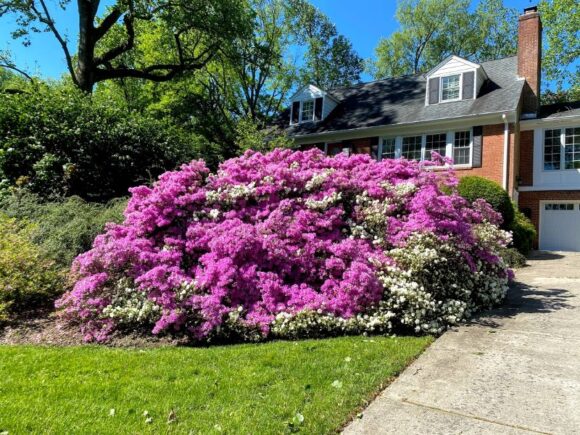
A note on mulch – only use the natural brown mulch of natural non-colored wood; do not use the colored mulches, which contain chemicals, and do not use rubber mulch.
A special word of caution on cocoa mulch. This product is highly toxic to dogs and cats — it is manufactured by Hershey and sold in many large garden centers.
It is made from the residue of chocolate products and others ingredients and contains a lethal ingredient that has resulted in the reported deaths of a number of cats and dogs that are attracted by the chocolate odor. It contains Theobromine, which is a Xanthine compound similar to the effects of caffeine and theophyliline. The symptoms for the animals are seizures and death within hours.
I wrote about the carbon component in my April tips but wanted to emphasize its importance by stating it again.
All living things including us are all carbon-based creatures. Humus brings carbon from the air into the soil.
Humus acts like a sponge and holds 90 percent of its weight in water. Because of its negative charge, plant nutrients stick to humus bringing nitrogen, calcium, phosphorus and other important elements to the plant, preventing these nutrients from washing away, acting like nature’s slow-release fertilizer.
Humus improves soil structure making it loose and friable, which helps plants to root in this environment with better access to nutrients, water and oxygen. Humus also helps to filter toxic chemicals from soil, much like carbon-based water filtration systems filter toxins from your water.
I recommend that you go online to Scientific American.com/article/Weed-Whacking Herbicide to check out the dangers of Round-Up. This is the most dangerous herbicide not only because of glyphosate, which is on the list by the World Health Organization as a chelating agent that causes cancer, but also because of the inert ingredients.
I ask that you are not swayed by the word ‘inert’ as the ingredients are anything but inert and those ingredients combined with Glyphosate are deadly to human cells.
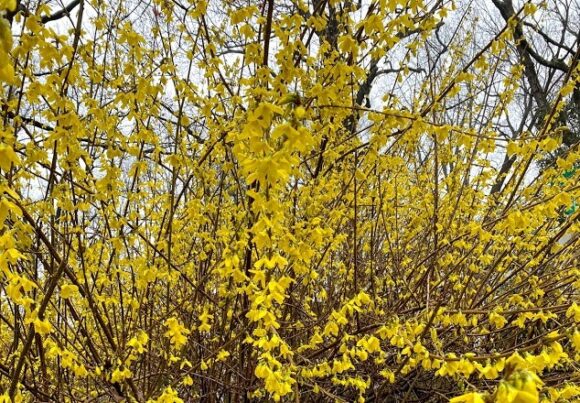
Forsythia is in bloom with lovely fresh yellow blossoms. If the bloom on your shrub is not as prolific as in previous years, prune out the old sparse wood after bloom ends.
A favorite native tree is the Serviceberry tree, with its creamy panicle blooms, followed by small green leaves and within weeks, red fruit, and a delicious menu for our feathered friends. Before the birds eat all the fruit, pick some to make a delicious jelly for your morning toast.
Here in my town of Old Lyme, the Magnolias, Cherries and Eastern Redbud are vying with one another to show their finery together with the graceful Dogwoods. Following the recent rains many of these trees are blooming at the same time or within a few weeks of one another. Their bloom will soon be over then we can look forward to rhododendrons, azaleas and mountain laurel into June.

The Carlesii Viburnum (also known as Korean Spice) is showing pink buds, opening to white flowers and their delightful fragrance fills the air outside my kitchen door.
Covering the barn wall and scrambling up to the barn roof is my climbing hydrangea – bright green leaves emerging with hundreds of buds indicating that this beautiful climber will be laden with blossoms in summer.
Tulips, creeping phlox, forget-me-nots, primroses and candytuft are bringing much-needed color to borders and rock gardens.
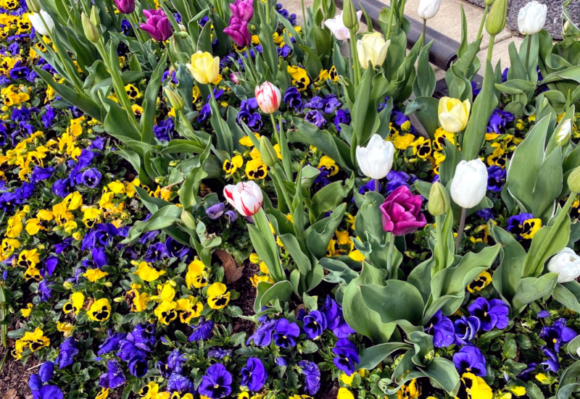
If you have not had time yet, for another week or two you can still prune your roses. Pull back the old mulch from around the base of the roses and in two weeks apply manure about six inches from the trunk of the plant. Then a week later reapply a layer of the brown natural mulch on top of the composted manure.
As well as building the humus component, these layers keep the roots cool, keep weeds at bay and help retain moisture. Do not mulch right up against the base of any plants as this encourages rodents to nest and gnaw on the plants.
Beware of fungi that look like weird mushrooms in your mulch; this is a sign of Artillery fungus and can stick and invade the walls of your home and cause problems. If you notice this fungus, you will need to remove all the mulch and get it off your property.
Apply lime and manure around the lilacs, they like sweeter alkaline soil, thus the lime. By now, you may have already applied lime to the grass, which also enjoys sweeter soil and organic grub control to kill the Japanese beetle larvae – less food for moles.
If you are making an organic vegetable garden this year, a garden measuring 16 ft. x 24 ft. can feed a family of four for a year, but keep the size within your needs and capability. Don’t work the soil if it is too wet or too dry.
Double-digging is the best way to go; it takes time and effort but its well worth it – dig down about one foot and remove the top soil, put to one side, then dig down and loosen the next six inches of soil and add about three inches of composted manure then put back the top soil and add another three to four inches of manure.
Do not rototill, as this will destroy soil structure. The gently loosened, aerated, fertile soil will give an excellent yield of fruits and vegetables in the garden.
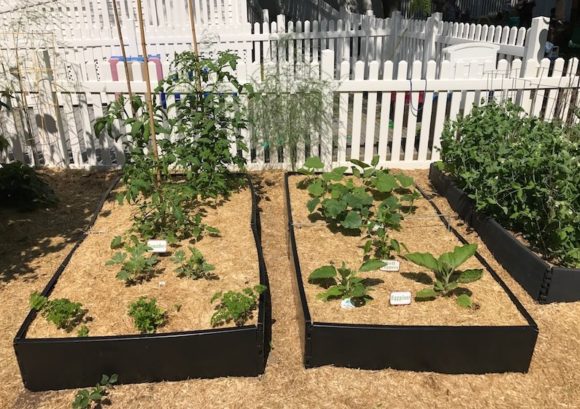
I prefer 6 ft. x 4 ft. beds rather than rows; beds produce a larger yield of crops. In addition, beds make for ease of weeding and harvesting by having narrow, compacted soil or grass paths (having removed lawn from the area) in-between the beds.
The vegetable garden should be situated on the south or southwest side of the property for maximum sun exposure.
Make sure you remove as many weeds as possible by hand, before you even begin digging.
You need a water source close by as vegetables require lots of water, particularly annual fruiting vegetables like tomatoes, which are hydroponics which means they are (mostly water).
Rotate crops, by that I mean, do not plant the same vegetables in the same place as the previous year. With this method you are preventing any soil-borne diseases from occurring.
In the loosened soil, plant the vegetables plants so that they are touching, this forms a natural canopy, shading out weeds and helps retain moisture.
I prefer to mulch the vegetable garden with composted manure, the reason being that manure, as mulch, does not cap. Capping is when mulch forms a crust, which does not allow water or air to penetrate to the roots of the plants.
Fence in the vegetable garden with a tall fence to keep animals out. At the base of the fence install eight inches of fine mesh chicken wire above ground and eight inches below ground to keep out the digging and burrowing animals.
Organic insect control:
Insects do not like fragrance so plant fragrant plants like marigolds, nasturtium, lavender, nepeta and honeysuckle and roses to name a few.
Encourage lacewings, which feed on aphids by planting marigolds and sunflowers,
Attract ground beetles by laying a log or a rock on the earth, under which the beetles can hide. These useful insects are nocturnal and eat slug and snail eggs, cabbage maggots, cutworms and even climb trees to feed on armyworms and tent caterpillars.
Grass is now a vibrant shade of green, therefore when mowing, keep the blades of grass at about three inches; the taller blades attracts sunlight, promoting a healthier lawn. The taller blades also shade out weeds and help to retain moisture in the grass.
When mowing, leave grass clippings on the lawn, the clippings are a natural source of nitrogen. If you have clover in the grass, clover is an added benefit as clover takes nitrogen from the air and fixes it in the soil providing additional nutrients for plant growth.
After flowering is over, prune flowering shrubs by 25 percent – do this task immediately before new buds set for next year.
On a rainy day go shopping for any garden supplies that may be needed, then when the weather is dry you can be outdoors doing what you love and not indoors shopping. Buy good hoses — cheap ones will bend and crack.
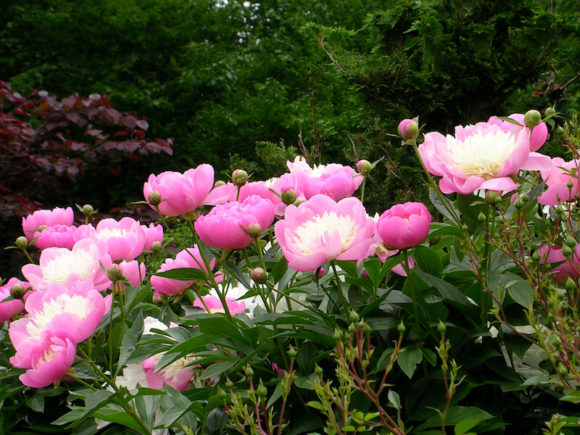
Peonies need plenty of water to produce flower buds. I have a 30 ft. long stand of Peonies in my field. The Peonies have been in the ground for over 40 years and are a sight to behold when in bloom. I give them lots of loving care with a light dressing of aged manure in early May. In a few weeks, I will pinch off the side buds while they are still small, leaving the terminal flower bud on each stalk, which will develop into a large main bloom.
Hydrangeas are a wetland plant and require plenty of water during the season, also applying manure and mulch around the base. If you have blue Hydrangeas and want a deeper color of blue, add some peat around the base of the plant — the acidity in the peat produces the color.
If you need to prune a Hydrangea, which has become too large, then prune it immediately after flowering, in early September by about one third of the old wood and the weakest shoots. Do not wait, as Hydrangeas begin to develop bloom buds for next year later in September.
If you wait to prune, you will not have bloom for next year.

My maternal grandmother’s favorite plant, the Lily of the Valley, soon will bloom tucked under the boxwood hedge on the north east side of the farmhouse near the front door. I love the delicate white flowers and fresh unique fragrance.
When the lilacs have finished blooming, pinch off the withered flower clusters, do the same on the mountain laurel and rhododendrons in late June to ensure good blossoms next year.
In mid-May apply composted manure, a light application of peat and fine bark mulch around all evergreens and rhododendrons, mountain laurel and azaleas; these plants are shallow-rooted and the mulch will keep the roots nourished, protected, warm and moist.
Some annual seeds that may be planted outside in mid May are: Calendula, Coreopsis, Marigold, Nasturtium, Nicotiana and Zinnia.
If you purchase annuals, on Mother’s Day weekend, place them in a sheltered spot on the south side of your home. Plant them no earlier than Memorial weekend as we can still get a late frost.
Tuberous-rooted begonias, caladiums, cannas and elephant ears can be moved from porch or cold frame to a part shade area as the weather becomes warmer and there is no sign of frost in the forecast.
If you staked trees, when they were planted last year, cut the stakes off at ground level. Do not pull them out of the roots as you could tear and therefore damage the root system.
Aphid tip: squish a few in your hand; dead aphids release a chemical that causes other aphids to drop off the plants.
Another ants and aphids tip – if you drink mint tea, sprinkle an y left-over tea on the bugs, as they do not like the smell of mint.
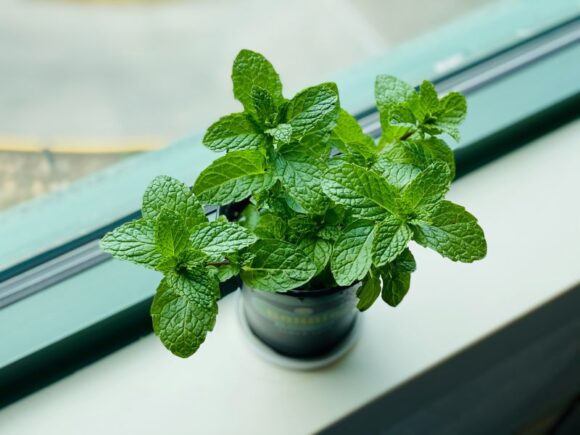
A word of caution on mint – plant mint only in containers, mint is tremendously invasive and can take over your garden.
When planting annuals, perennials, vegetables, trees, shrubs or evergreen, keep them watered but not drowned.
Houseplants can be moved outdoors for their summer sojourn at the end of May. However, do not put your African Violets outdoors as they will burn, but rather move them to a porch that is covered and shaded, or keep them indoors in a window that does not receive direct rays from the sun.
Wait until the soil warms up at the end of May to set out Dahlia tubers.
Roses are not the troublesome creatures you have been led to believe. I prefer to plant David Austin roses; these shrub roses are repeat bloomers with lovely fragrances. Roses need at least four hours of sun per day, good air circulation, and excellent drainage.
During their growing period from the beginning of June to mid August; add a little extra composted manure each month; it may be applied over the mulch. Stop adding the manure in August so that the roses can go into a slow dormancy.
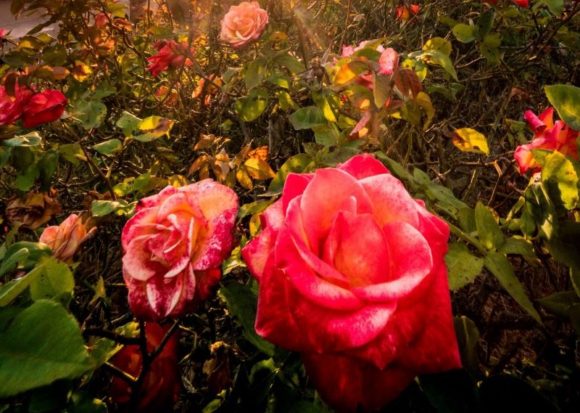
Roses like the same growing conditions as Clematis and planted together in companionship planting, they flourish well together, with feet in the shade and head in the sun. Before you top up the soil around the roses, add water and check if the soil drains, roses need good drainage. Deep watering is recommended at least once a week.
Plenty of stuff to keep you hopping, folks, and remember to keep your eye out for any pest trouble and when you spot it get on the ball immediately to avoid further problems. Carefully discard all herbicides and pesticides; these poisons have the same effect on your health as second-hand smoke.
Your garden offers an anchor for peace and quiet enjoyment. Enjoy the warmth, the gentle breeze, the earth’s fragrance and bloom and please remember to breathe.
Contact Maureen at maureenhaseleyjones@gmail.com

About the author: Maureen Haseley-Jones, pictured left, is a member of a family of renowned horticultural artisans, whose landscaping heritage dates back to the 17th century. She is one of the founders, together with her son Ian, of, ‘The English Lady Landscape and Home Company.’ Maureen and Ian are landscape designers and garden experts, who believe that everyone deserves to live in an eco-conscious environment and enjoy the pleasure that it brings. Maureen learned her design skills from both her mother and grandmother, and honed her horticultural and construction skills while working in the family nursery and landscape business in the U.K. Her formal horticultural training was undertaken at the Royal Botanic Gardens at Kew in Surrey.